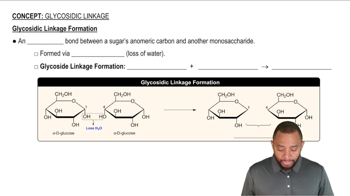For each of the following disaccharides, name the glycosidic bond and draw the monosaccharide units produced by hydrolysis:
(a)

 Verified step by step guidance
Verified step by step guidance Verified video answer for a similar problem:
Verified video answer for a similar problem:



 1:44m
1:44mMaster Glycosidic Linkage Formation Concept 1 with a bite sized video explanation from Jules
Start learning